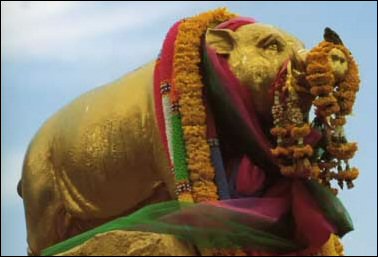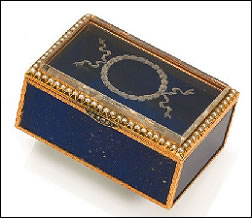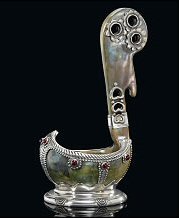
New Livadia Palace
(Courtesy of the Authors)
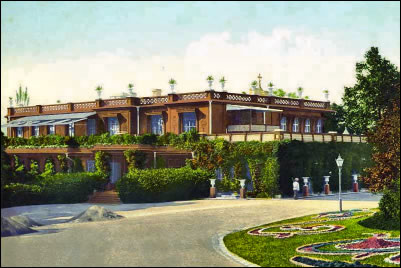

Old Livadia Palace from an Early 20th Century Postcard, Construction of the New Palace
(Courtesy Liki Rossii)
Events after the consecration:
September 20, 1911 The Imperial family arrived in Livadia.
September 27, 1911 Baron Vladimir Freedericksz, Minister of the Imperial Court, sent a document entitled, Proposals on Awards for Productive Work on Building of the Livadia Palace, to Emperor Nicholas II suggesting different types of rewards – official ranks, State orders, valuable presents recognizing everyone who took part in the project. The Baron proposed three different classes of jettons (gold with enamel, gold, and silver) commemorating the event.
September 30, 1911 Approval by Nicholas II of the jettons and the recommendation to depict the profiles of the Emporer and Alexandra Feodorovna cited in a letter which was sent by Alexander Mosolov, Head of the Chancellery of the Minister of the Imperial Court in St. Petersburg. Mosolov was with the Emperor in Livadia and wrote to his assistant Prince Sergei Gagarin – The Emperor wished, besides all other awards for building the Livadia Palace being given on October 5, to grant jettons to participants in building the Palace … Handwritten note was added by Mosolov on behalf of Nicholas II (RGIA F. 472. Inv. 45. File. 45, p. 76 Opposite).
October 5, 1911 Name day of Tsesarevich Alexis, the celebration and awarding of gifts (except the jettons) took place. Three well-known jewelers, Bolin, Fabergé and Edward Kortman, were invited to take part in a competition. On October 20, 1911, eleven different drawings were submitted. The Emperor chose the drawing #4 suggested by Carl Fabergé. The order was placed for the jettons by Baron Freedericksz with a caveat – the price fixed by Fabergé was too high in his opinion. The first class jettons were priced at 90 rubles, and the other two classes at 65 rubles and 25 rubles, respectively. (The authors’ grandmother told us she lived with her husband and a child for 3 rubles per month before the 1917 Revolution.)
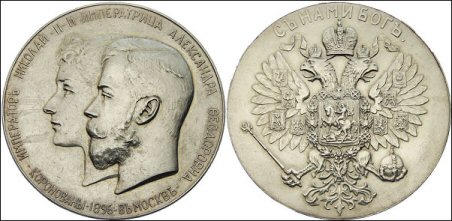
1896 Coronation Medal of Nicholas II
(Courtesy Liki Rossii)

Plaster Cast of the Livadia Palace Jetton
(Courtesy of Livadia Palace Museum)
Unfortunately, the authors were not able to find an extant copy of the 263 jettons issued, but found a plaster cast of the jetton (above) on display in the Livadia Palace Museum.
On March 5, 1912, the completed jettons were sent to the Head of the Chancellory of the Minister of the Imperial Court, Alexander Mosolov, with a bill for 9,980 rubles.

Fabergé Bill for 263 Commissioned Jettons
(Courtesy of the Authors)
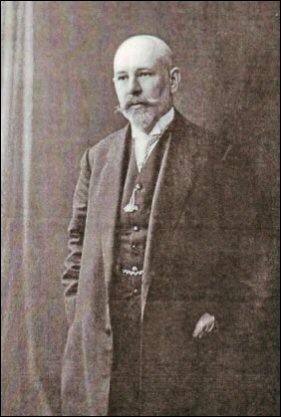
Architect Nikolay Krasnov with Jetton in His Upper
Buttonhole (Courtesy Livadia Palace Museum)
Eight individuals receiving the highest rank of first class jettons and their residences at the time of their death are:
- Minister of the Imperial Court Count Freedericksz (1838-1927) – died in Grankulla, Finland in 1927 (He was a Count after 1913.)
- Chief of the Ministry of the Household of His Majesty the Emperor, aide-de-champ-general, Prince Victor Kochubey (1860-1923) – died in Wiesbaden, Germany
- Assistant of the Chief of the Ministry of the Household of His Majesty the Emperor, Count Mikhail Nirod (1852-1930) – died in Paris, France
- Assistant of the Chief of the Ministry of the Household of His Majesty the Emperor, Nil Likharev (1856-1913) – died in Russia
- Chief of the Cabinet of His Majesty Emperor Nicholas II, Major-General Evgeny Volkov (1864-1933) – died in Nice, France
- Chief Manager of Livadia and Massandra Estates Vladimir, Kachalov (1864-1942) – died in St. Petersburg, Russia
- Chief of the Palace in Livadia Major-General, Pyetr Yanov (1853-1921) – died in the Crimea
- Architect Nikolay Krasnov (1864-1939) – died in Belgrade, Serbia
Newsletter readers with additional information are encouraged to contact the editors.
The Standart, the most luxurious yacht of the time was built by order of Emperor Alexander III of Russia, and constructed by the Danish shipyard of Burmeister & Wain in Copenhagen, beginning in 1893. The vessel, 420 feet in length, was launched on March 21, 1895, and came into service early September 1896. Boinovich, A. and Yu. Sibirtsev in Istoria Russkogo Flota v Znakakh I Zhetonakh (History of Russian Fleet in Tokens and Badges), 2009, p. 66, describe special jettons for service on the Standart: (1) Approved in 1906 for 10 years of service with an X and the dates 1896-1906 on the verso, and (2) Approved in 1911 for 5 years of service with the dates of service on its verso, for example, 1907-1912, or any other 5-year time period.
A gold jetton with an enameled Imperial eagle fitting the description for (2) and the Putyatin’s drawing from Korneva and Cheboksarova (below left) plus an engraving on the medal sold at auction (Sotheby London, June 7, 2007, Lot 541 with an error in the workmaster attribution – “Alexander Thielman”) brings to light more historical information. Alexander Tillander, an independent retail jeweler with a workshop, and Alfred Thielemann, a workmaster in the House of Fabergé, both used the AT mark on the jettons they made.
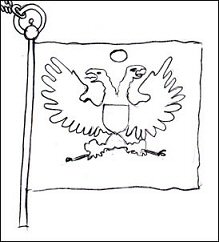
Double-headed Eagle Jetton Sketch
Based on Putyatin’s Drawing
(Courtesy Korneva and Cheboksarova)

Standart Jetton
(Courtesy McFerrin Collection
© C&M Photographers)
Biographical information discovered about the jetton recipient is based on the Cyrillic engraving, Captain / S.R. Nevyarovsky / 1907-1912, on the verso of the 1½ in. (3.5 cm) jetton. Stanislaw R. Nevyarovsky (1879-1934, Paris), mechanical engineer, Catholic, married, speaks French, English, and German, in naval service since 1898, and received a gold medal for five years of service on the Imperial yacht Standart in 1912, also in the same year he received the commemorative medal to mark the 100th anniversary of the War of 1812, Captain – 2nd rank in 1913 …
Another source states: In 1917, he did not return from a trip to England. In exile, he lived in France. Since 1924, member of the Company’s former students of the Naval Engineering School in Paris. The Secretary of the Union Guards officers. The author of an essay, ‘Death Svetlana [a ship]’ published in the book, From the Fleet of Admiral Rozhdestvensky, Prague, 1930.
Greg King in his book, The Court of the Last Tsar (p. 280), writes, “the yacht had a permanent assignment of seventeen officers, led first by Captain Neverovsky (sic) who, on his retirement in 1912, was replaced … “
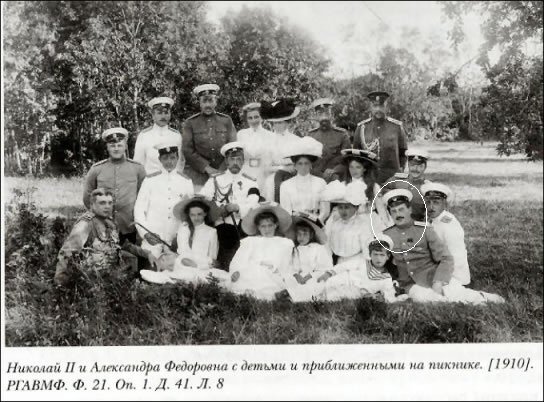
Imperial Family at a Picnic in 1910 with Captain Nevyarovsky
(Courtesy Alexander Palace Time Machine Discussion Forum)
My thanks to contributors – Tim Adams (USA), Tatiana Cheboksarova, Galina Korneva, Valentin Skurlov (all of St. Petersburg, Russia), Annemiek Wintraecken (Netherlands), Ulla Tillander-Godenhielm (Finland), and Joanna Wrangham (Canada).
With the generous assistance of art collector and connoisseur Douglas A. Latchford, a resident of Bangkok, three types of commissioned medallions have been identified with a 1913 date. Silver medallions with one enameled pig were presented to persons of a lower position, gold ones with one pig to a more elevated position than the previous category, and gold ones with two pigs also required the recipient to have been born in a Year of the Pig.

Silver, One Pig with
Leather Strap
(Courtesy Douglas
Latchford)
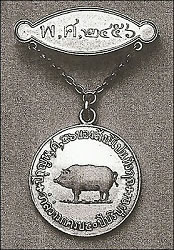
Gold, One Pig, Gold Brooch Bar
(Courtesy Spink)
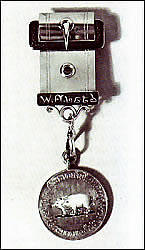
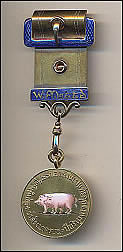
Gold, Two Pigs, Born in Pi Kun
(Illus. in Snowman, Carl Fabergé, 1979, 124;
Colored Photographs Courtesy of the Collector)
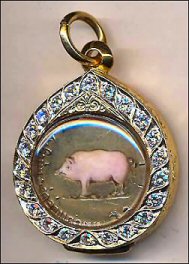
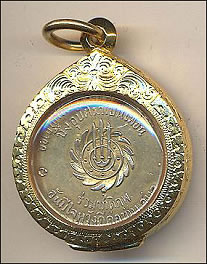
Medallion Converted to an Amulet
(Courtesy Douglas Latchford)
(Updates are posted in Exhibitions on the Fabergé Research Site)
Fabergé at the Venaria. The Jewellery of the Last Tsars
More than 150 Fabergé objects including 13 Easter eggs from The Link of Times Foundation of Moscow will be on view. The exhibition commemorates the relationship between the courts of the Romanovs and the Savoys of Italy. (Courtesy Alessia Sturli)
Extended till August 19, 2012 Stark Museum in the Memorial Student Center, Texas A&M University in College Station, Texas
The Allure of Fabergé: Selections from the Dorothy & Artie McFerrin Collection
A tradition begun in 2007 when nine Fabergé enthusiasts met in London to attend the Rothschild Egg auction was continued four years later when 55 admirers of Fabergé’s art traveled from Europe, Canada, and the United States to the Virginia Museum of Fine Arts in Richmond for a gathering during the opening events of the Fabergé exhibition. Through the generosity of Artie and Dorothy McFerrin and the Houston Museum of Natural Science the third gathering of enthusiasts will take place January 30 – Feburary 1, 2013, in Houston, Texas.
Carl Fabergé’s 166th birthday was celebrated with a Google Doodle.
Elsebeth Welander-Berggren of Stockholm was recently awarded The King’s Medal (HM Carl XVI Gustaf of Sweden) for Important Achievements as a Museum Director. In 1997, she was the exhibition director and editor of Carl Fabergé: Goldsmith to the Tsar (1997) for the Nationalmuseum, and today, she is still active in museum work and an admirer of Fabergé.
Congratulations! Dr. Valentin Skurlov, author and independent Fabergé researcher in St. Petersburg (Russia), successfully defended his dissertation, History and Traditions of Fabergé in the Stone-cutting Art of Russia (End of the 19th and the Beginning of the 21st Century).
The Robb Report, December 2011, p. 172, features a gold and quartz Fabergé snakehead cane handle. Similar handles are illustrated in Carl Fabergé: A Private Collection, p. 139 (2012).

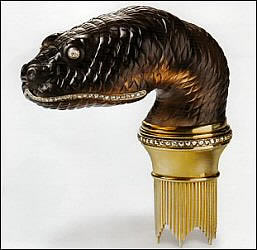

Cane Handles
(left, Courtesy A La Vieille Russie and Wartski)
Cannot travel but you want to admire Fabergé? Several museums have digitized their Fabergé collections so enthusiasts can enjoy them on their personal computers:
Baden-Baden, Germany Fabergé Museum
Baltimore, Maryland The Walters Art Museum
Cleveland, Ohio Cleveland Museum of Art
London The Royal Collection (search by workmaster’s last name)
Moscow “The Link of Times” Foundation
Moscow Moscow Kremlin
St. Petersburg, Russia The State Hermitage Museum
Washington (DC) Hillwood Estate, Museum & Gardens
Wartski, London. Carl Fabergé: A Private Collection, 2012. Beautifully illustrated exhibition catalog for the Harry Woolf Family Collection of over 150 objects carefully selected by the owner, who in the foreword elegantly explains his passion. The introductory text by Geoffrey Munn of Wartski reflects further on 40 years of collecting by the owner.
A copy of the Schaffer Collection of Authentic Imperial Russian Art Treasures catalog dated 1936 is mounted online.
Fabergé, Tatiana F., Kohler, Eric-Alain, and Valentin V. Skurlov. Fabergé: A Comprehensive Reference Book, 2012. US Distributor: traveltom@aol.com
Although over 3,000 books and articles on Carl Fabergé and his works have been published so far, most of their authors were content to repeat systematically the same things and to give credit to legends and gross errors. Most of these publications are based on information provided by Eugène Carlovich Fabergé [1874-1960, eldest son of Fabergé] in the 1930s and used by H.C. Bainbridge, the first biographer of Carl Fabergé in 1949.
The inability to access essential archival material meant that Fabergé scholars were previously unable to authenticate their work. Letters written by the Tsars [Alexander III and Nicholas II], Fabergé’s invoices, Cabinet documents and Bolshevik inventories had all been hidden away within Russia since the Revolution.
Furthermore, another important and valuable source of information had never been exploited by any Fabergé specialist: namely, the Fabergé family papers which comprise documents handed over through four generations. They include rare literature, the London Sales Ledgers, lists of goods confiscated during the Soviet period in Saint Petersburg and extremely interesting photographs, such as the pictures of the amazing silver table service made by Fabergé Moscow for the gold magnate Alexander Kelkh.
For over ten years the authors researched the forbidden Russian archives and studied the additional unpublished material to make this remarkable book, supported by a wealth of documentary evidence much of which has never been published before. This is the first complete and definitive work to disclose the fascinating history of the House of Fabergé. (Press Release and book cover, courtesy of Tatiana Fabergé)
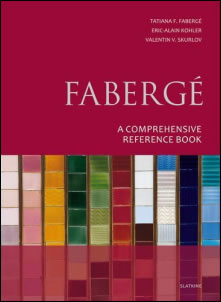
Fabergé: A Comprehensive Reference Book
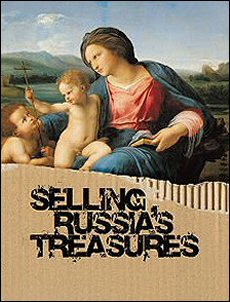
Selling Russia’s Treasures
(Courtesy Natalya Semyonova)
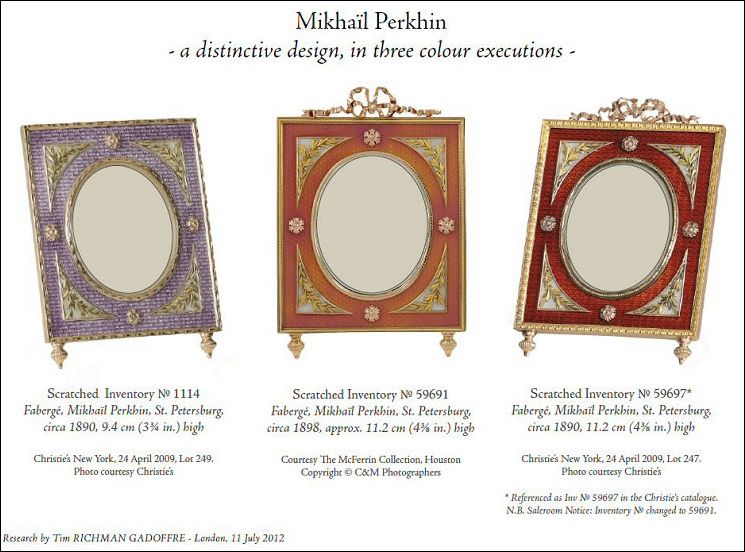

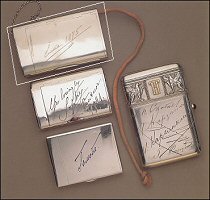
Christmas 1875 Cigarette Case
(Courtesy von Habsburg and Traina)
Provenance: Given by Empress Maria Feodorovna (‘Minny’) to her future son-in-law, Grand Duke Alexander Alexandrovich (1866-1933) in 1875; Prince Theodor of Russia, his son; Prince Michael Romanov, his son. (von Habsburg, Fabergé: Imperial Craftsman and His World, 2000, p. 329 – #869B)
In the listing of provenance, the progression of ‘his son’ assumes the box was originally given to Grand Duke Alexander Mikhailovich. The dates given (1866-1933) are for the life of Grand Duke Alexander Mikhailovich. There seems to be some confusion here between the ‘Alexanders’ Alexandrovich and Mikhailovich. If the case in question was given by ‘Minny’ at Christmas 1875 to Grand Duke Alexander Alexandrovich (1845-1894), it was to her husband then Tsarevich during the reign of Tsar Alexander II (not her ‘future son-in-law’).
Stepping back to a previous caption accompanying the Christmas 1875 Case (Traina, John, The Fabergé Case, 1998, 156), the provenance reads: Gift from Empress Marie Feodorovna to her future son-in-law, Grand Duke Alexander Mikhailovich on Christmas 1875. Inherited by Prince Michel Romanoff de Russie from his father, Prince Theodor of Russia, son of the Grand Duke Alexander and Grand Duchess Xenia, sister to Czar Nicholas II.
While this case was inherited through the children of Alexander Mikhailovich and Xenia Alexandrovna, I would respectfully suggest it surely could not have been given as a gift from ‘Minny’ to Alexander Mikhailovich at Christmas 1875. For it was in 1875 that Xenia was born, and Alexander Mikhailovich (her future son-in-law) was only 9 years old, having been born in 1866. Indeed the subject of a marriage between Alexander and Xenia was not broached until 1890, and Alexander did not become Minny’s son-in-law until his marriage to Xenia in 1894. Actually it was in 1881, indeed the year of the assassination of Tsar Alexander II, that Alexander (‘Sandro’) actually met the seven-year-old Grand Duchess Xenia. On this occasion, the children of Tsarevich Alexander Alexandrovich and Marie Feodorovna (Minny) were invited to a party at the Winter Palace, as Alexander II was eager for them to meet the three children of his second marriage to former mistress, Catherine Dolgorouky/Princess Yourievsky. Included in this event were the Tsar’s brother Grand Duke Michael Nikolayevich (Viceroy of the Caucuses) and his children (including Alexander Mikhailovich), who were dubbed the ‘Wild Caucasians.’
As Fabergé remains the focus of this discussion, there is a Fabergé element in the historical digression presented here. Through the early 1880’s, the companions, who first met at Alexander II’s party, including a group of Russian friends, began taking the 9:30 train to Gatchina Palace (home of Alexander III, Minny, and their children) for luncheon every Sunday. There followed games on the palace lawn, “rides on the miniature railway in the park with its tunnels, stations, bridges and its engines, replicas of real locomotives, which could reach speeds of 4 or 5 mph.” The Potato Society, a secret society, was formed by the young people, as was common at that time. It took its name from: “… an incident on a paper chase when the pursuers were told the ‘fox’ had ‘shot into the potatoes’.” (van der Kiste & Hall, Once a Grand Duchess: Xenia, Sister of Nicholas II, 2002, 17) Denoting membership, each person was given a gold charm in the form of a potato fashioned by Fabergé.
A two volume set of The Personal Illustrated Inventories of Jewellery and Bibelots from 24th June 1880 to 1905, and of Jewellery from 12 January 1894 to 25 March 1912 of Ksenia (Xenia) Alexandrovna, Grand Duchess of Russia (1875-1960) recently sold at auction. (Bonhams, London, The Russian Sale, November 30, 2011, Lot 155) The charm is described as: “A curiously shaped object presented by ‘Georgi’ resembling a potato may well serve as a sort of visual shorthand for the secret society which counted Ksenia and her brother among its members.” (Ed. Note: The brothers are George Alexandrovich, 1871-1899, and Tsar Nicholas, 1868-1918.)
The charm’s design sketch in the Xenia jewelry album is not available due to copyright restrictions. The kind assistance of Sophie Hamilton Law at Bonhams is most sincerely appreciated. Is anyone aware of a potato charm by Fabergé? Contact the Editors.

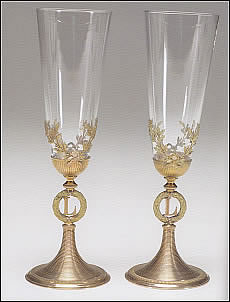
Champagne Flutes
(Courtesy Christie’s and Fabergé Revealed, 2011, 162-3)

